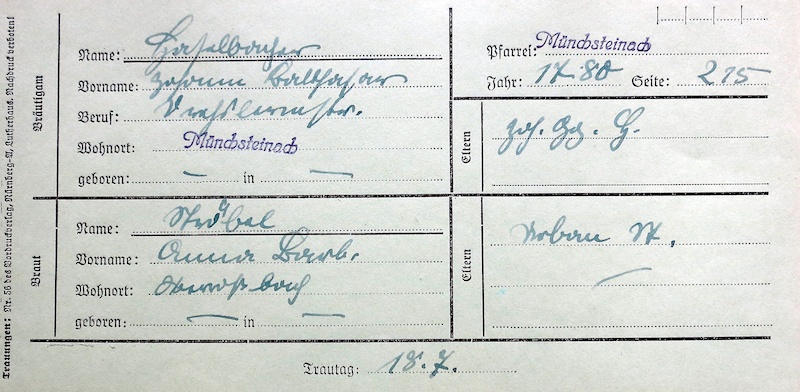Abstracts of Church Records from Münchsteinach, Germany
This is just a holding page.

During my last trips to Germany, I collected more information than I have been able to process. I particularly enjoy examining old documents to try to sort out what life was like back in the 17th, 18th, and 19th centuries. I have acquired some rudimentary skills in the German language, but the fact that most of the old church documents are handwritten in the old script makes translation time-consuming for me.
My most recent effort was an analysis of the list of communicants in Münchsteinach. What I am aiming for is to organize all available original documents in the way I begun with my Bayerl family in southern Bavaria, and the Hasselbachers of Diespeck. So that you can begin to benefit from what I have gathered, I will start to post some material without translation or analysis. (Perhaps some of you can help me!)
Here is the first batch from Münchsteinach– abstracts of births, deaths, and marriages. Some time in the very early 1900s [I think], someone went through the church books for these sacraments and transcribed the basic (but not all) information onto index slips using modern German script thus making the records more accessable. This also allows many years of records to be arranged alphabetically. Not all Churches did this. I encountered this specific transcription system in Diespeck, and in Lautershausen. The fact that the books from Diespeck were transcribed as far back as the late 1600's fortuitously allowed even me to organize over 200 years of Hasselbachers from that village. Of course, I needed someone to help me translate the modern script, but once that occurred, it was like a gift from heaven. (The person who helped me from Diespeck has become a good friend– another gift from the family history adventure.)
In a series of pages linked below, I attach all the index slips from Münchsteinach that refer us Hasselbachers. In the case of marriages, I tried not to miss a Hasselbacher bride, but it is possible I did so because the records were alphabetized only by the groom. (This is an issue familiar to family historians!) Because the abstracts note the page number, they greatly facilitate finding the original entry. One weakness of the Münchsteinach abstraction process is that it only begins with records from the later part of the 1700s. While there are some other places we can look to help identify and translate older records, this means we are largely on our own. The search is worth it, as even from this summer's visit, I learned about Hasselbacher cousins whose existence was previously unknown to me. It has been some 7 years since I first saw such cards in Diespeck. I am amazed that I can actually read them now myself!
The index cards on the pages below are arranged alphabetically. Right now it is pretty much a data-dump of images. As time permits, and as I dissect the original documents, I will add links and notes and present a table to make it easier to identify a given record.
Look here for Births. [15 records, 2 MB]
Look here for Deaths. [9 records, 1.1 MB]
Look here for Marriages. [5 records, 0.85 MB]